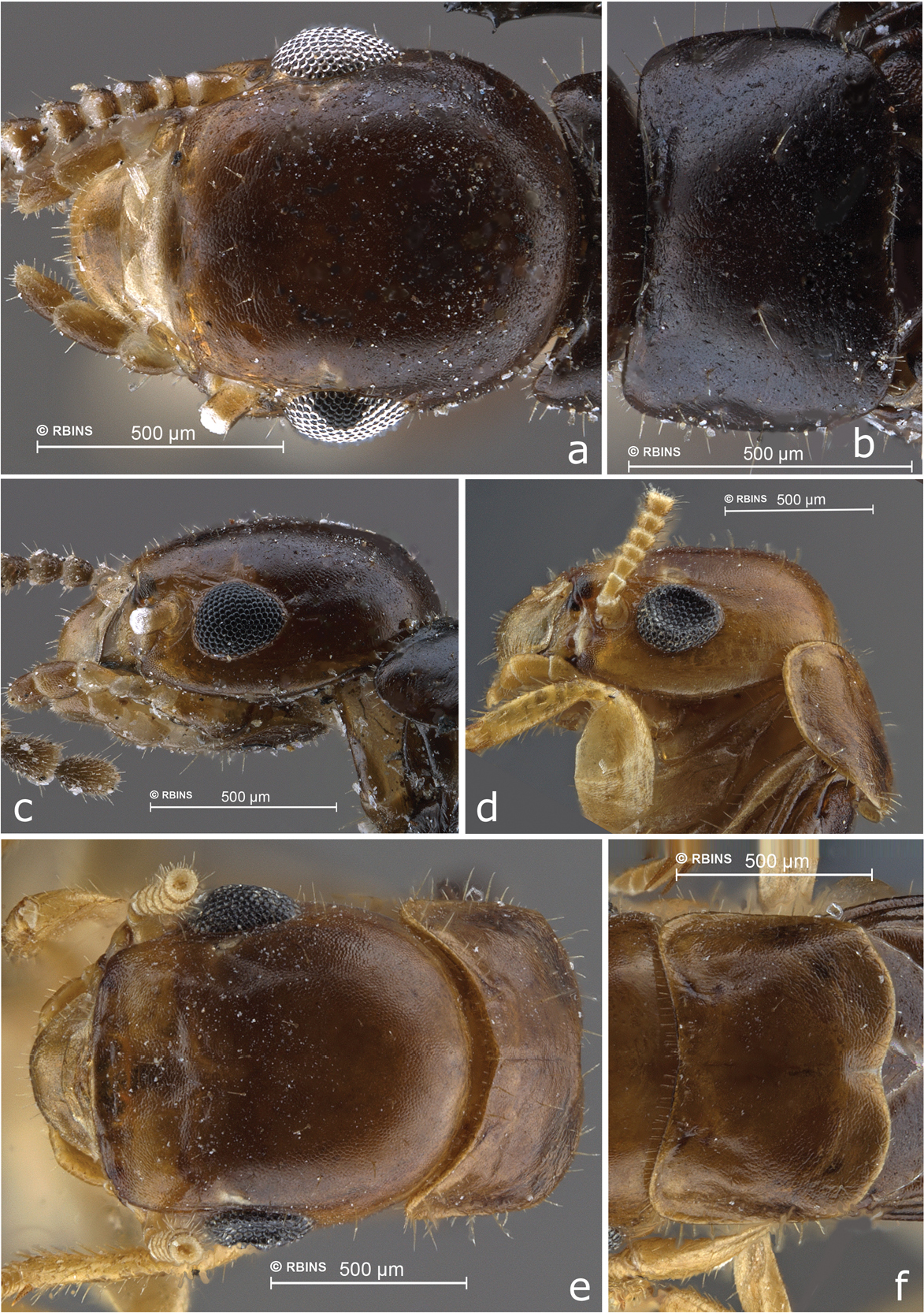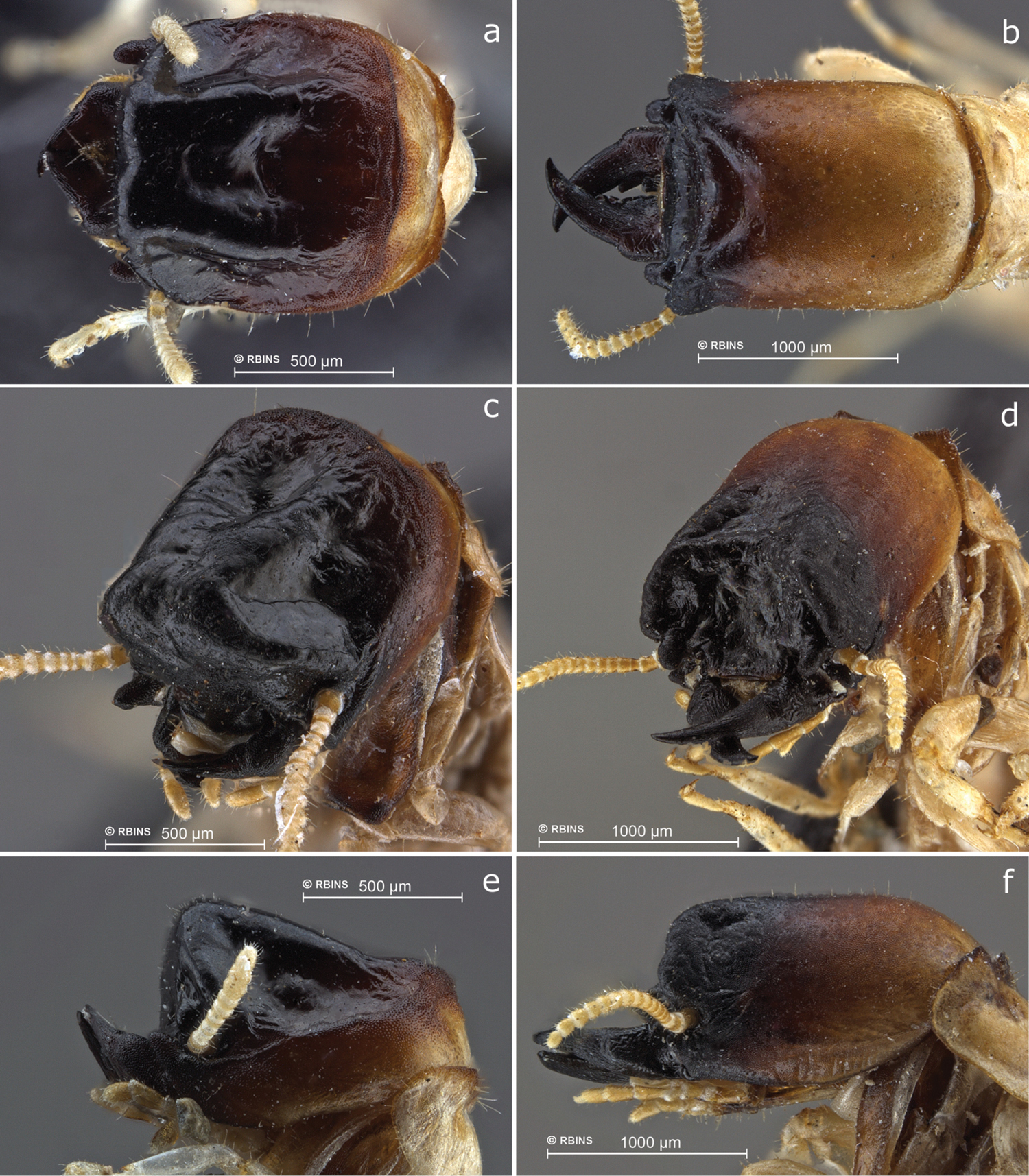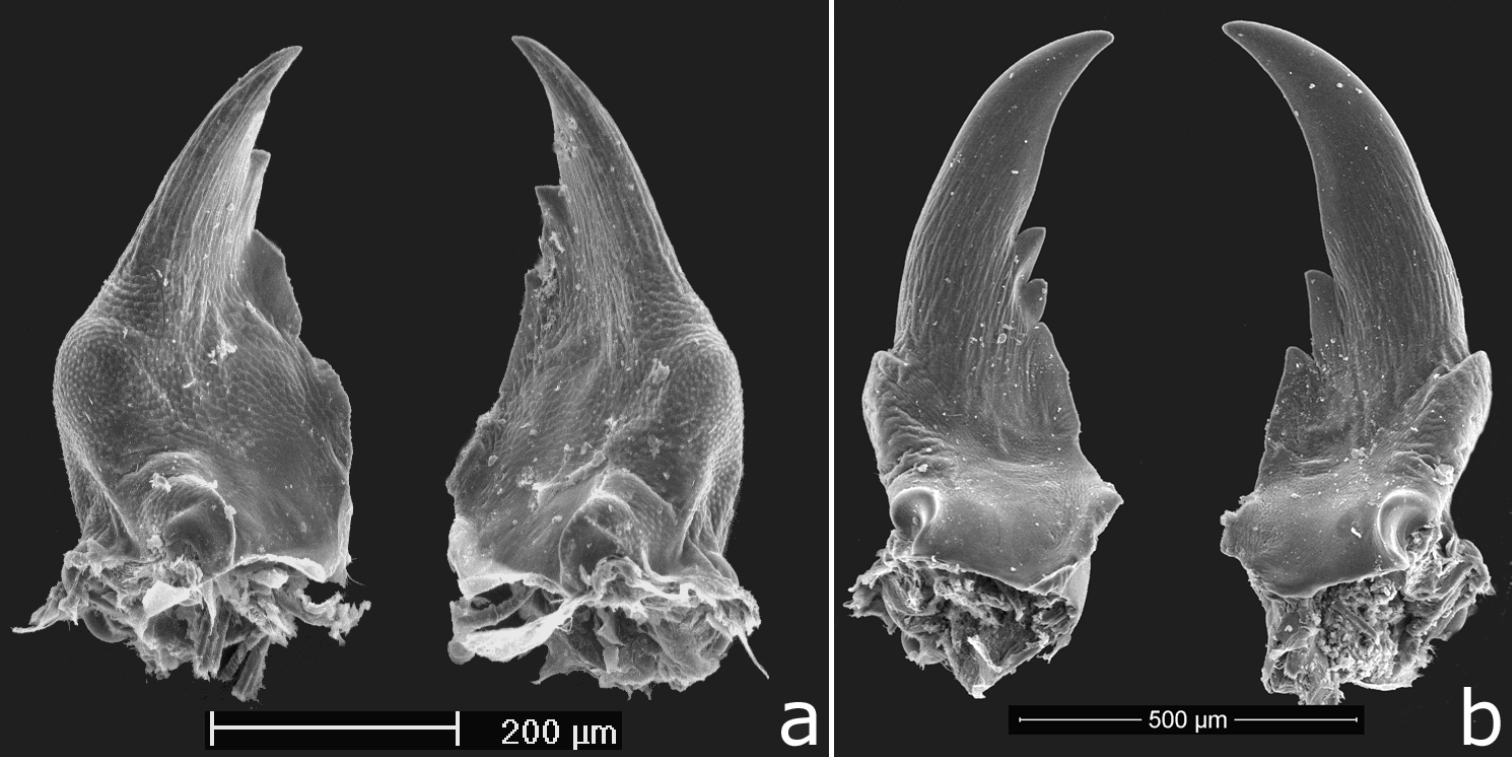






(C) 2011 Yves Roisin. This is an open access article distributed under the terms of the Creative Commons Attribution License, which permits unrestricted use, distribution, and reproduction in any medium, provided the original author and source are credited.
For reference, use of the paginated PDF or printed version of this article is recommended.
Complete series of two species of the phragmotic drywood termite genus, Cryptotermes (Isoptera: Kalotermitidae), were found on Espiritu Santo, Vanuatu. Here, I describe for the first time the soldier of Cryptotermes albipes (Holmgren & Holmgren), which resembles Cryptotermes domesticus but presents deep depressions on the head sides and vertex. The other species, here described as Cryptotermes penaoru sp. n., comes close to Cryptotermes tropicalis, a species known from the tropical rainforest of northern Queensland, from which its soldier is distinguished by its more elongated head capsule.
Isoptera, Cryptotermes: Vanuatu, new species
The termite family Kalotermitidae, often called drywood termites, is present in all tropical, subtropical and warm temperate regions of the world (
The family was revised at the genus level by
Collections took place between 9–26.xi.2006 in the Saratsi Range above Penaoru village, on the west coast of the Cumberland Peninsula, Espiritu Santo, Vanuatu, as part of a multiple-taxa survey of arthropods along an altitudinal gradient (
Series of optical images of specimens were taken with a Leica DFC290 digital camera mounted on a Leica Z6APO microscope, then combined by Helicon Focus software. SEM images were obtained with a Philips XL 30 ESEM.
Measurements and their abbreviationsMeasurements were taken to the nearest 0.005 mm with a Wild MMS 235 length-measuring set fitted to a Wild M6 stereomicroscope.
Imagos: ED – Eyes maximum diameter; OD – ocellus maximum diameter; HLP – Head length to postclypeus; HWE – Head width, maximum including eyes; HWI – Head width, interocular; PW – Pronotum width (not flattened); T3L – Hind tibia length; FWL – Forewing length (without scale).
Soldiers: HLP – Head length to postclypeus; HLF – Head length to frontal flange; HLG – Head length to genal horn; HW – Head maximum width; PW – Pronotum width; LML – Left mandible length (seen from below, from condyle to tip); LW – labrum width; HD – head depth, excluding postmentum; PML – Postmentum length; MPW –Maximum postmentum width; T3L – Hind tibia length.
Collections and their abbreviationsANIC Australian National Insect Collection, Canberra, ACT, Australia
MNHM Muséum National d’Histoire Naturelle, Paris, France
NHMB Naturhistorisches Museum Basel, Switzerland
RBINS Royal Belgian Institute for Natural Sciences, Brussels, Belgium
ULB Université Libre de Bruxelles, Belgium
Most of the samples presently housed in the author’s collection at the ULB will ultimately be deposited at the RBINS.
Taxonomyhttp://species-id.net/wiki/Cryptotermes
Imagos of Cryptotermes can be recognized by the combination of the following criteria: left imago mandible with anterior margin of third marginal tooth clearly longer than posterior margin of first plus second marginals, and media vein bending forward to join radial sector in middle of wing or beyond.
Soldiers of Cryptotermes have a phragmotic head (like those of Calcaritermes) and all fore tibial spurs approximately equal.
http://species-id.net/wiki/Cryptotermes_albipes
The type series of this species only contains imagos.
Paralectotypes: NEW CALEDONIA: Loyalty Islands: Maré Island, 17.xi.1911 (coll. Sarasin & Roux), alates only (NHMB). Other material: VANUATU: Taféa: SW Tanna Island, 28.vii.1971 (coll. K.E. Lee, det. J. Buckerfield), alates and soldiers (ANIC#15344); Sanma: Espiritu Santo, 28.x.1982 (coll. R.L. Paton, det. J. Buckerfield), alates and soldiers (ANIC#18883); Espiritu Santo, 10.xi.2006 (coll. det. Y. Roisin), with 1 alate, sexuals, soldiers and immatures, on forested slope above Penaoru village, alt. 300m a.s.l. (14°57.98'S, 166°38.22'E) (ULB #Santo016); ibidem, 12.xi.2006 (coll. det. Y. Roisin), soldiers and immatures (RBINS #15607); ibidem, 16.xi.2006 (coll. det. Y. Roisin), sexuals, soldiers and immatures from dead branch about 15m above ground (RBINS #15616).
(Figs 1a, 1c, 1e)Redescribed by
Head and pronotum of imagos a–c Cryptotermes albipes a head from above b pronotum c head from left side d–f Cryptotermes penaoru, paratype from colony #Santo080 d head from left side e head from above f pronotum.
Measurements of 6 paralectotype alates and 13 sexuals (5 alates, 8 dealates) from 4 colonies (non-type specimens between parentheses): ED: 0.270–0.310 (0.265–0.325); OD: 0.080–0.120 (0.070–0.130); HLP: 0.825–0.930 (0.835–0.885); HWE: 0.845–0.960 (0.830–0.925); HWI: 0.635–0.700 (0.620–0.665); PW: 0.755–0.885 (0.700–0.835); T3L: 0.690–0.745 (0.675–0.755); FWL: 5.06–6.11 (5.25–5.55).
Its pigmentation pattern (dark to very dark brown with pale, almost white tibiae contrasting with dark brown femora and yellow tarsi) distinguishes this species from all other Cryptotermes in this area.
(previously undescribed) (Figs 2a, 2c, 2e, 3a)Head capsule very dark reddish brown to black. Head in dorsal view slightly convex on sides and on posterior margin; trapezoidal in profile, narrowing posteriorly. Frontal flange not raised, with medial notch. Frons flat, making an angle <90° with plane of mandibles. Genal horns well developed, pointing upwards; frontal horns reduced to low humps. Deep depression on vertex, delimited by broad, blunt crests running backwards from highest points of frontal flange. Sides of head capsule concave. Mandibles rather short and stout, with sharp cutting edge and small teeth. Antennae pale brown, of 10–12 articles. Pronotum widely and angularly notched, with thickened anterior margin.
Heads of soldiers a, c, e Cryptotermes albipes a from above c oblique view from upper left front side e lateral view b, d, f Cryptotermes penaoru, paratype from type colony b from above d oblique view from upper left front side f lateral view.
SEM pictures of soldier mandibles, from above a Cryptotermes albipes b Cryptotermes penaoru (paratype from colony #Santo080).
Measurements of 6 soldiers from 5 colonies: HLP: 0.975–1.230; HLF: 0.955–1.215; HLG: 0.975–1.230; HW: 0.920–1.085; PW: 0.795–1.075; LML: 0.495–0.615; LW: 0.185–0.225; HD: 0.730–0.890; T3L: 0.525–0.625.
Vertical to overhanging frons distinguishes Cryptotermes albipes from all other species from the area except Cryptotermes domesticus. Depression in middle of vertex with conspicuous anteroposterior ridges on both sides is characteristic of Cryptotermes albipes.
Cryptotermes albipes is known from the Loyalty Islands (east of New Caledonia) and Vanuatu (Espiritu Santo and Tanna). It also occurs in New Guinea (unpublished data). Its biology is poorly known. On Santo, this species was found at 300m a.s.l. in dead tree trunks on the ground, as well as in a dead branch on a living tree at a height of 15m. Colony boundaries seem rather diffuse. Several reproductive pairs can be found in the same log, and may possibly reside in the same network of interconnecting tunnels.
urn:lsid:zoobank.org:act:B0BB619F-6C57-4E5E-A30C-4B07B306C723
Samples of this species were previously identified as Cryptotermes tropicalis Gay & Watson (
Holotype, soldier: VANUATU: Sanma: Espiritu Santo, 09.xi.2006 (coll. det. Y. Roisin), in standing dead wood, on forested slope above Penaoru village, alt. 100m a.s.l. (14°57.69'S, 166°37.90'E) (ULB #Santo003; RBINS #15589: type colony). Paratypes: alates, 1 soldier and immatures from type colony (same data as holotype); ibidem, 18.xi.2006 (coll. det. Y. Roisin), 1 male (dealate), 3 soldiers, immatures (ULB #Santo080).
(Figs 1b, 1d, 1f) Overall colour medium brown; head, pronotum and wing scales darker; legs paler, with femora paler than tibiae; abdominal sternites palest. Wings brown, paler than tergite colour, with pimple-like nodules. Head parallel-sided, almost ciruclar behind. Eyes large; ocelli large, oval, contiguous to eyes. Antennae of 14–16 segments in alates, broken down to 7 segments in dealate of colony #Santo080. Pronotum almost as wide as head, widely concave anteriorly, with convex sides narrowing posteriorly, posterior margin biconvex. Pilosity of head and pronotum sparse and short. Wings with subcosta, radius and radial sector sclerotized, and slight sclerotization of cubital branches. Media unsclerotized, except at junction with radial sector, beyond half length of wing. Arolium present.
Measurements of paratypes: 4 alates from type colony (#Santo003) and 1 dealate from colony #Santo080 (parentheses): ED: 0.265–0.295 (0.275); OD: 0.100–0.115 (0.090); HLP: 0.950–1.000 (0.950); HWE: n.a. (0.935); HWI: 0.695–0.730 (0.705); PW: 0.810–0.910 (0.865); T3L: 0.745–0.870 (0.825); FWL: 6.82–7.15 (n.a.).
(Figs 2b, 2d, 2f, 3b)Head capsule from ferruginous posteriorly to black in frontal area. Mandibles almost black, antennae and labrum dark orange. Head quadrangular, distinctly longer than wide, with straight parallel sides and convex posterior margin. Frontal flange prominent only on sides, extending as low ridges backwards at an angle of ~45° with sagittal plane. Frons-vertex ridge concave, delimiting with posterior extensions of frontal flange a triangular depression anteriorly on vertex. Frons falling steeply on postclypeus. Frontal horns stout, prominent, blunt. Genal horns very small, blunt. Slight lateral depression and rugosity posterior to frontal flange. Eyes visible as distinct pale spots. Mandibles long, with prominent external hump at basal third. Marginal teeth small but distinct. Antennae of 10–15 articles. Pronotum widely and angularly notched, with thickened anterior margin.
Measurements of holotype, paratype from type colony [brackets] and 3 paratypes from colony #Santo080 (parentheses). HLP: 1.755 [1.675] (1.610–1.650); HLG: 1.615 [1.645] (1.560–1.580); HW: 1.250 [1.165] (1.135–1.175); PW: 1.175 [1.055] (1.035–1.095); LML: 1.025 [0.950] (0.955–0.995); LW: 0.320 [0.270] (0.260–0.325); HD: 1.025 [0.920] (0.925–0.950); T3L: 0.920 [0.875] (0.775–0.815).
This species comes clearly close to Cryptotermes tropicalis, from Queensland, but can be distinguished by its more elongated head.
Cryptotermes penaoru was found in a single site in lowland forest near Penaoru village, hence its name. The type colony was collected from a small standing dead tree.
Cryptotermes penaoru clearly belongs in a group of moderately phragmotic species with low or medially indistinct frontal flange, weak to moderate lateral rugosity behind frontal flange, and relatively long mandibles with distinctive marginal teeth. This group includes the Australian species Cryptotermes tropicalis, Cryptotermes primus, Cryptotermes austrinus, Cryptotermes queenslandis and Cryptotermes simulatus, which form a monophyletic lineage (
I thank the Muséum National d’Histoire Naturelle (Paris), Pro-Natura International, the Institut de Recherche pour le Développement (IRD, France), and the Ministry of Lands (Republic of Vanuatu) for giving me the opportunity to participate in the “Santo 2006” expedition. Thanks are also due to the Penaoru villagers for their warm welcome and kava parties. Other entomologists taking part to the expedition, and especially M. Leponce, helped in the field. M. Lenz and L.R. Miller (CSIRO) facilitated access to ANIC samples, and M. Brancucci (NHMB) loaned me the types of Cryptotermes albipes. I also thank Y. Laurent and I. Bachy (RBINS) for photography and image processing, and J. Cillis (RBINS) for SEM assistance.


